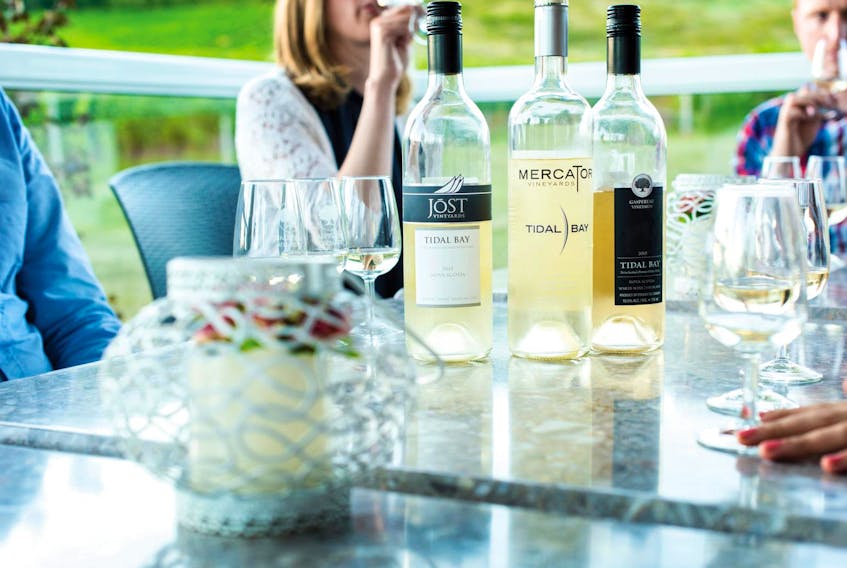Nova Scotia’s grape-growing clout is on the rise nationally and internationally, so there ought to be a product that captures the desirable characteristics found in wines in this region.
Tidal Bay is just that.
“The Tidal Bay wine is an incredible piece of marketing designed to showcase our ability to make world-class whites,” says Jeremy Novak, of Wolfville, N.S.
Novak is with the tour service Where It’s At tour in the Annapolis Valley, and is a frequent tour guide with the Magic Winery Bus, which brings wine lovers to a variety of wineries in the area for tastings.
Jurg Stutz, winemaker at Grand Pré Winery in Nova Scotia, agrees. He feels Tidal Bay showcases what can be done in the region with the grape varieties grown locally. It elevates the overall quality perception for Nova Scotia wines and helps the industry promote the region nationally and internationally, he says.
Nova Scotia has a unique growing climate, explains Rachel Lightfoot, part of the winemaking and management team at Lightfoot & Wolfville Vineyards.
“The ocean influence and cool-climate imparts a distinctive freshness and vibrancy in our wines that really represents Nova Scotia in a glass,” said Lightfoot. “The Tidal Bay appellation celebrates and promotes this uniqueness and has helped create a regional identity based on a style of wine we can produce really well, bringing the industry together at the same time.”
What is Tidal Bay?
Stutz was part of the technical group that created the Tidal Bay standards for aromatic whites. It was officially launched by the Winery Association of Nova Scotia in 2012, though discussions about creating a signature wine for Nova Scotia had been happening for some time prior to that, he says.
To be considered a Tidal Bay, the Wine Association of Nova Scotia’s website says all wines must be made from specific grape varieties, contain 100 per cent Nova Scotia-grown grapes, follow a strict set of standards and be approved every year by an independent blind-tasting panel.
Tidal Bay, says Lightfoot, is enjoyable on its own as a crisp, refreshing summertime white or paired with fresh seafood and salads.
Because of the different combination of grapes used by winemakers, each Tidal Bay wine variety tastes slightly different.
Wine tastings
Novak recommends having a Tidal Bay tasting party with friends to help determine a favourite variety. Norm Surette, from Wolfville, N.S., is an expert at hosting these events.
“We have been holding the Tidal Bay event since 2012, when the first vintage of the appellation was released, and have not missed a year,” he says.
Surette has even created what he calls the entirely pretentious umbrella organization OWSOW (Original Wine Snobs of Wolfville) to sanction the event.
To begin with, Surette narrows the selection to six Tidal Bay wines to taste. After their release in May, he tries to taste them all, either at a farmers’ market or by visiting the vineyards.
“One standing rule is that the previous year’s champion is always invited back to defend their title,” he says.
The Tidal event has a set format that Surette has used from the beginning, starting with eight testers and 48 glasses arranged on the table.
“Each glass has a coloured sticky attached on the stem with the initials of the taster written on it. The colour coding is to identify the wine and the initials help people to not mix glasses with others,” explains Surette.
While guests are in another room, Surette pours a small amount of wine into the eight colour-coded glasses, doing this for each wine. The bottles are then hidden away in the fridge so only Surette knows which wine is associated with a particular glass colour. Guests then try each wine, making notes on a provided sheet.
“We recommend small sips, as guests will likely wish to go back to certain wines and compare them to ones to come later,” Surette says.
Once all the wines have been tasted, each guest is provided with a scoresheet and asked to rate the six wines. Once scores are tallied, Surette returns to reveal the wines, and which one was that year’s winner.
“The whole afternoon usually takes about two and a half hours, with fun had by all,” says Surette.
Those who would like to taste test Tidal Bay wines but are not up for hosting their own party, can join the Tidal Bay annual release event traditionally held in May, sponsored by the Winery Association of Nova Scotia.
LEARN MORE:









